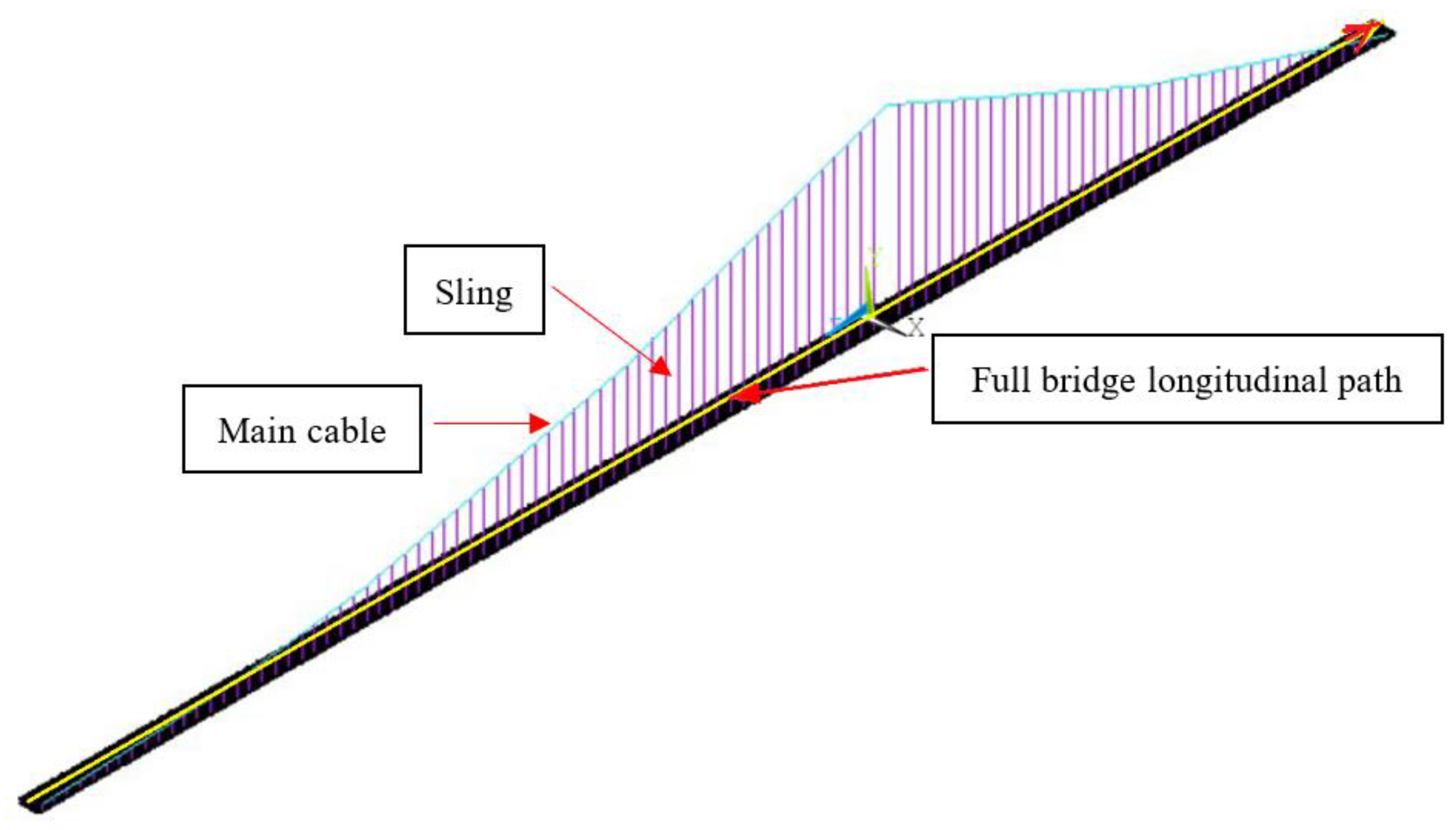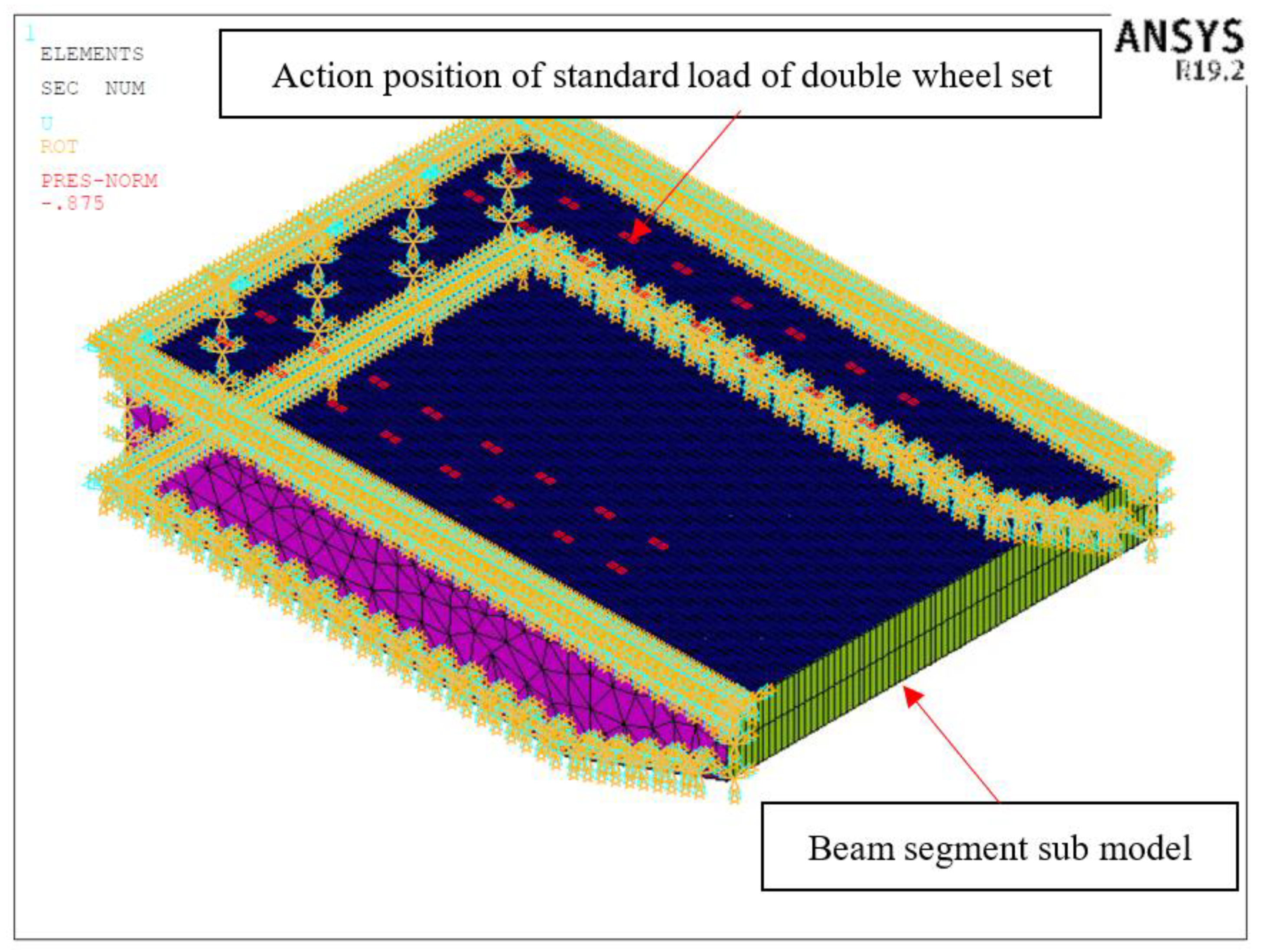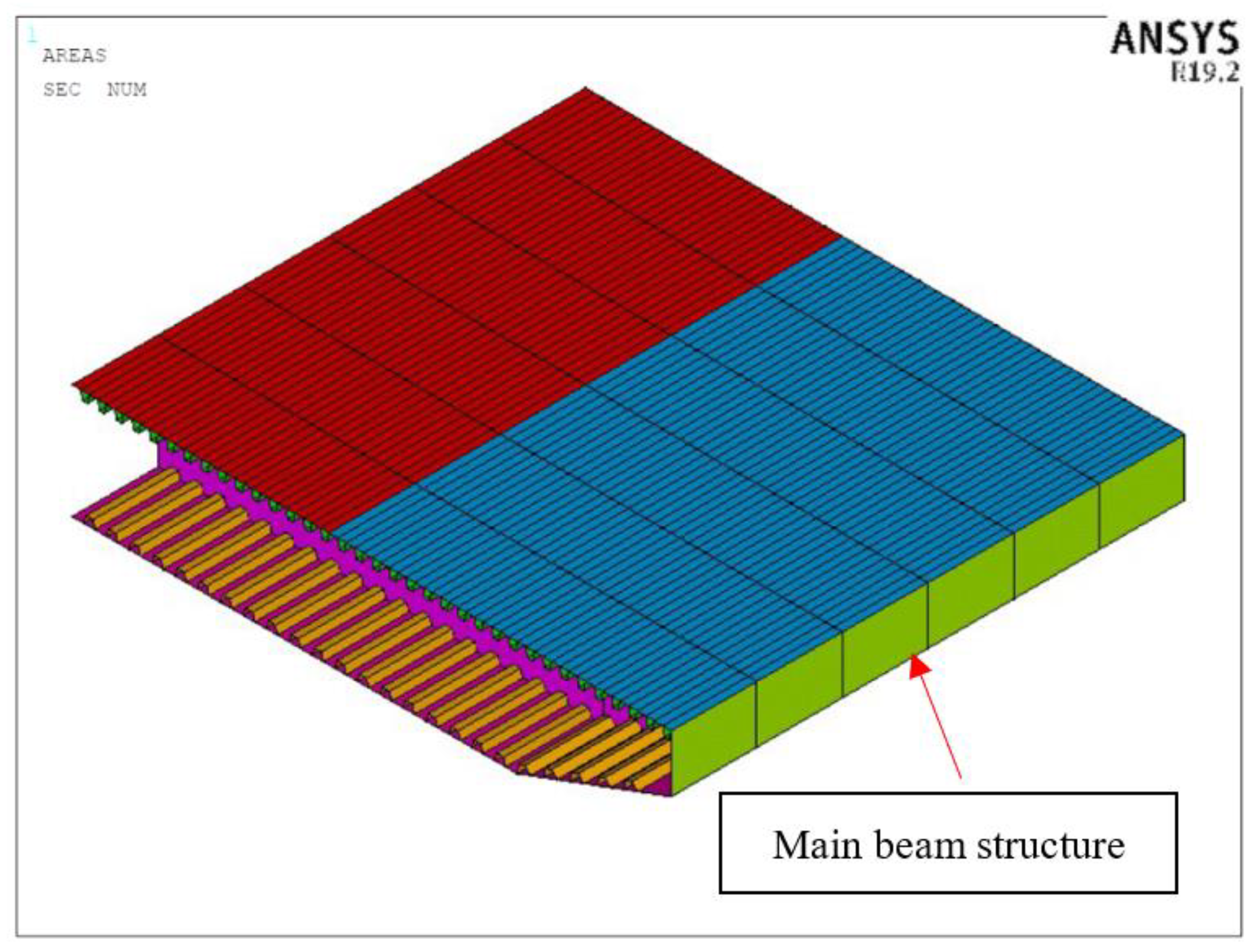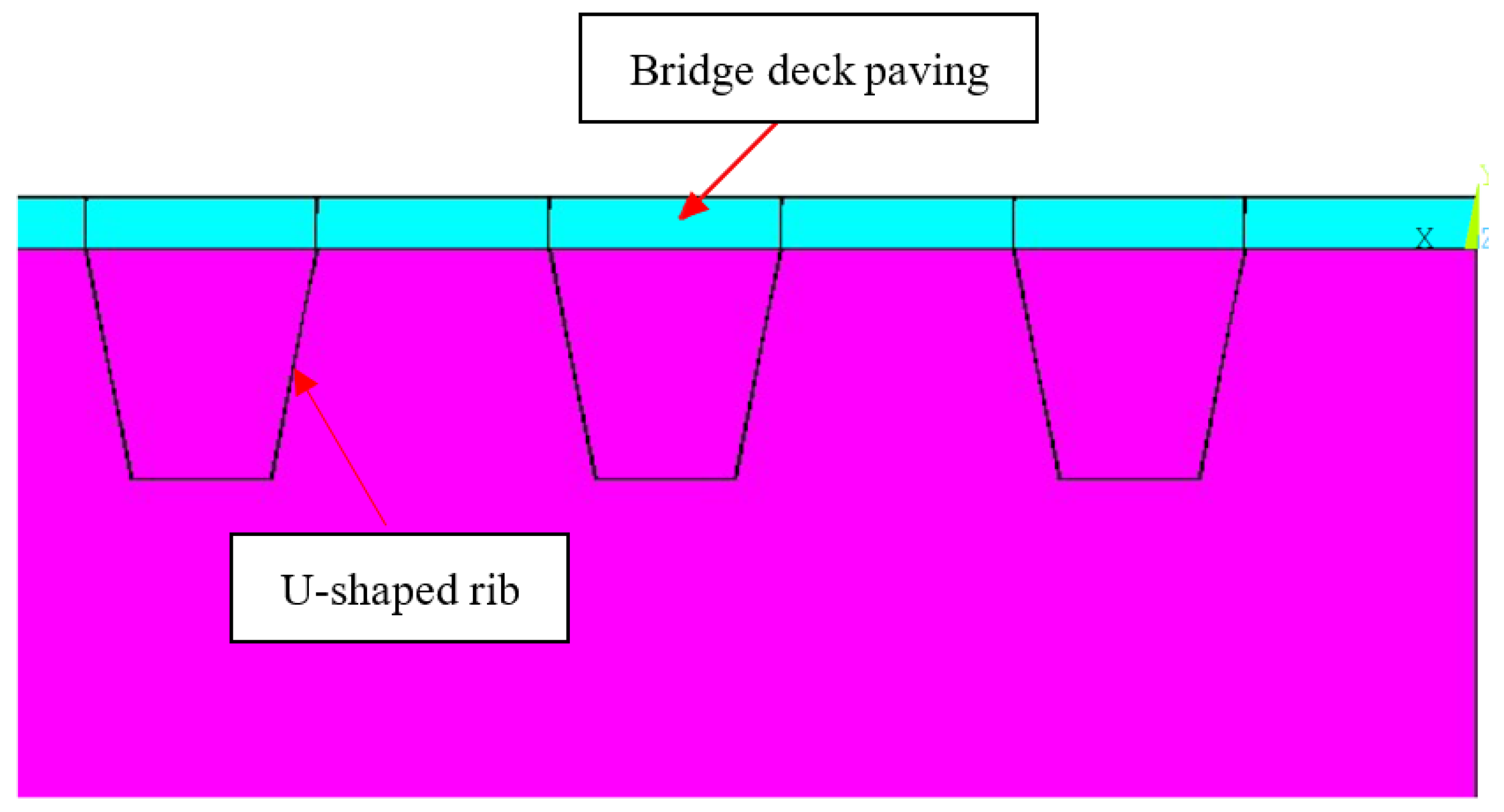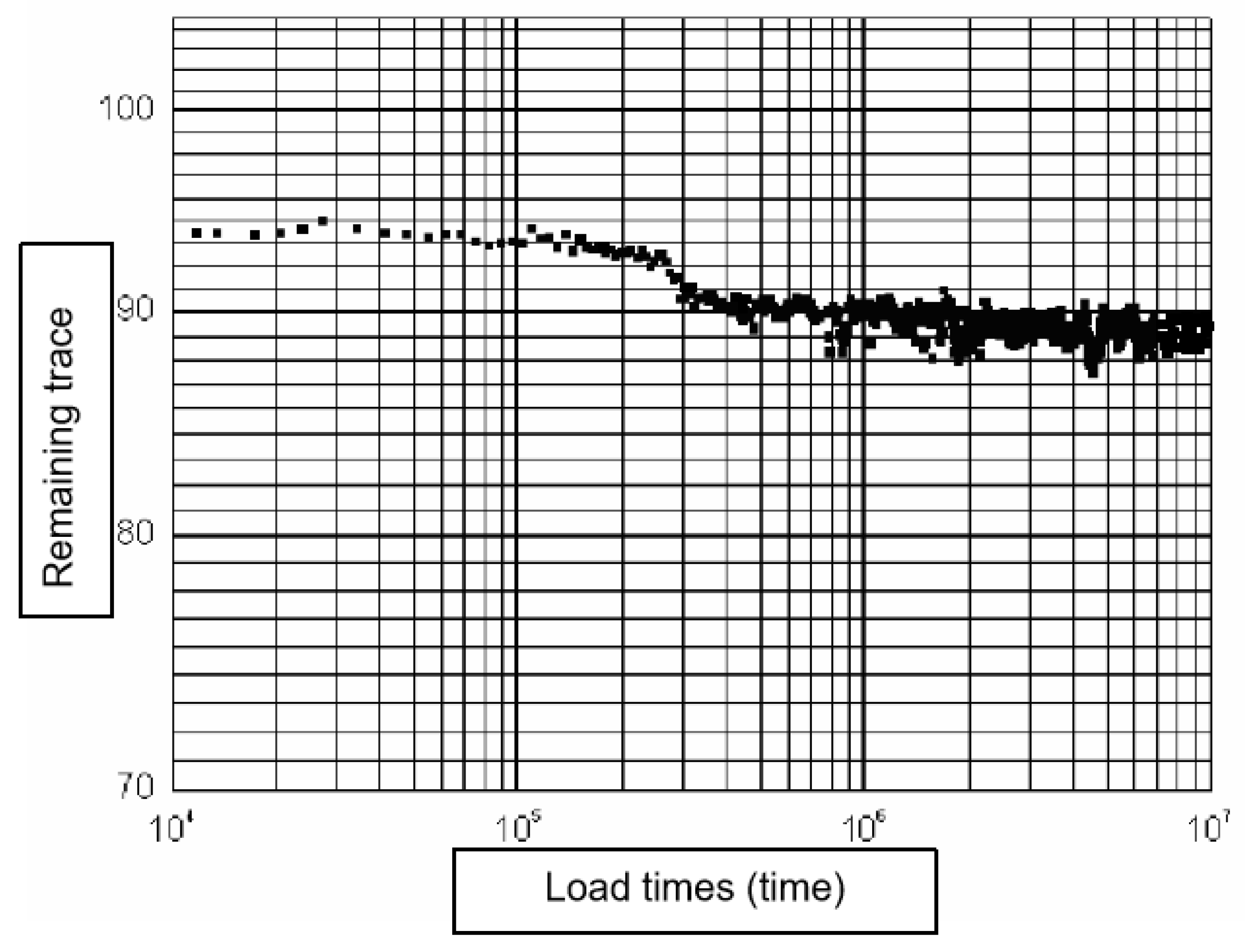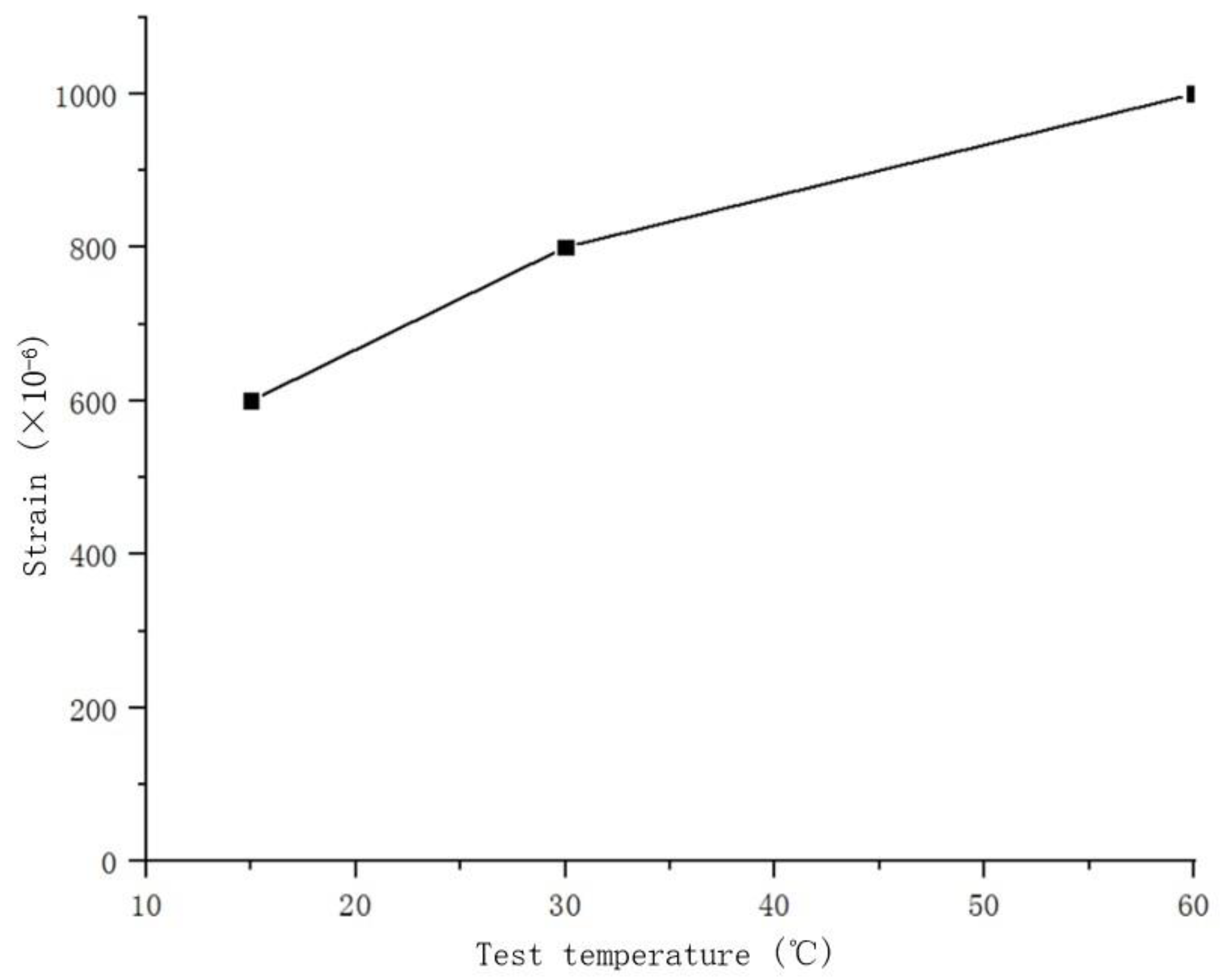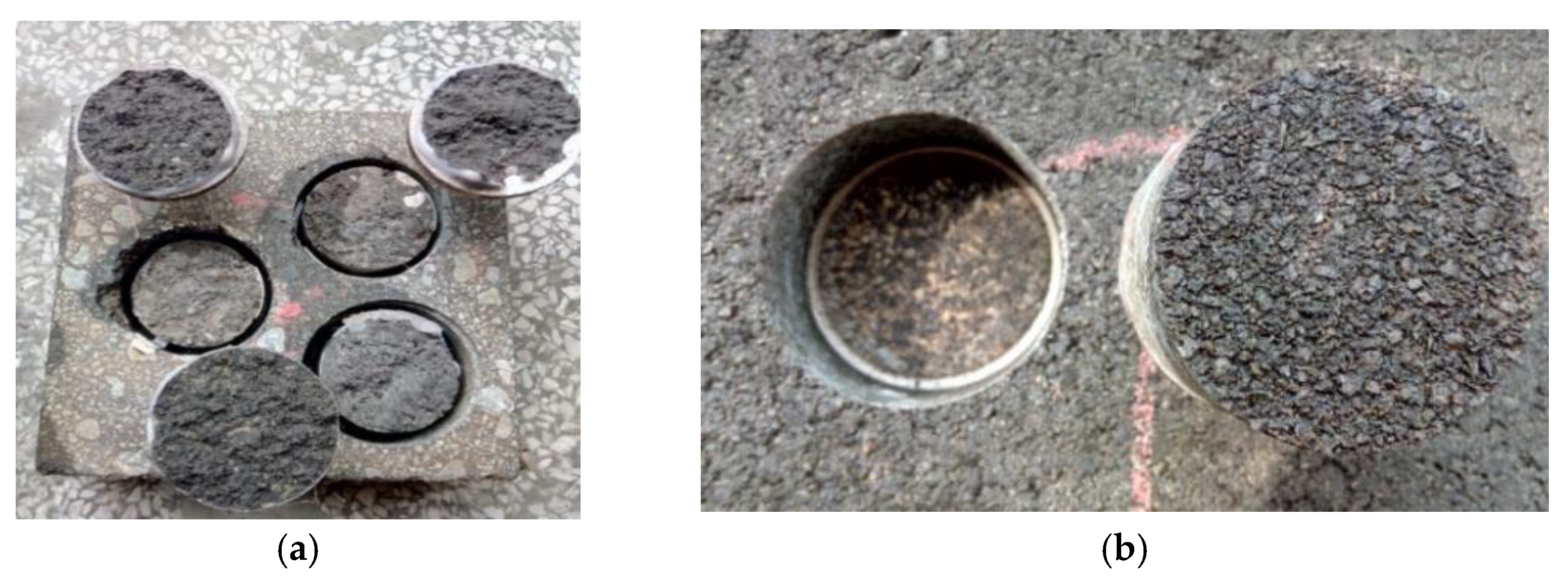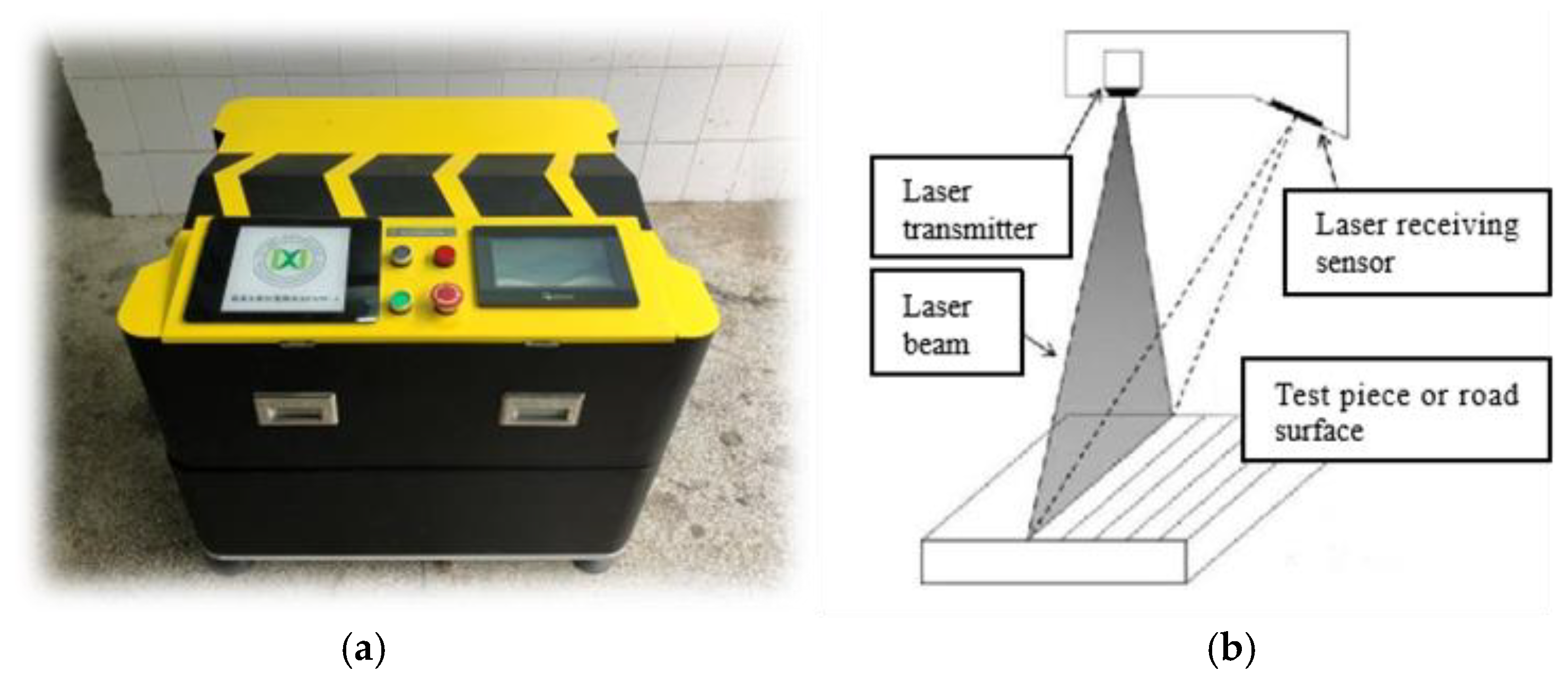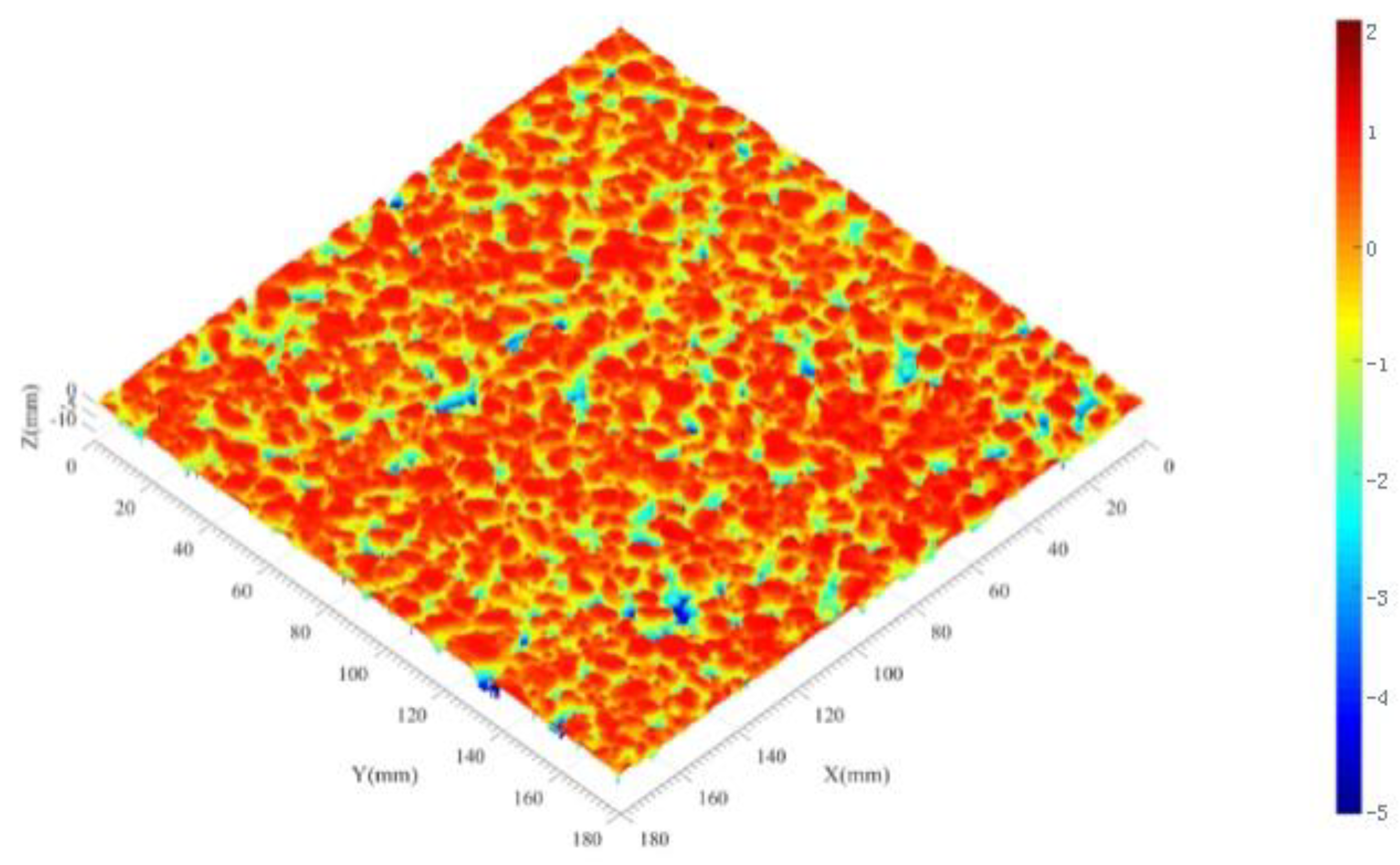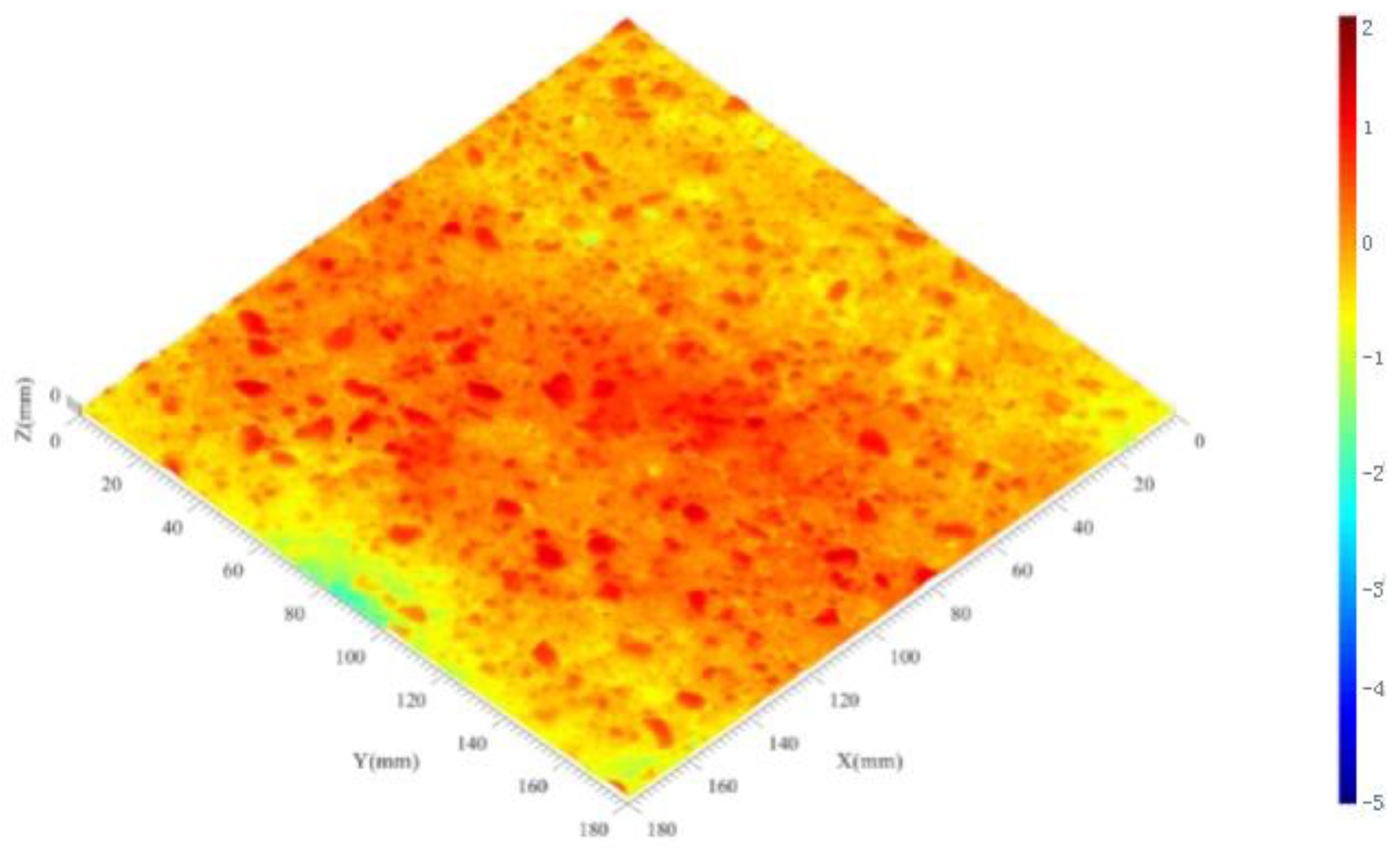1. Introduction
The pavement of long-span steel bridge decks is a worldwide engineering and technical difficulty. The pavement structure must have a certain degree of following deformation with the steel plate, water tightness, and anti-skid performance to ensure its requirements on durability and function [
1,
2].
Guangdong Province is located in tropical and subtropical regions with year-round high temperatures and rainfall, especially near the Pearl River Estuary, where it is quite hot, rainy, humid, and highly salty all year round. Therefore, strict requirements are imposed on how to protect the steel plate of the steel bridge deck from corrosion, as well as the anti-skid performance to ensure safe driving in rainy weather [
3,
4].
Epoxy asphalt is a mixture of epoxy resin, curing agent, and base asphalt through chemical reactions [
5,
6,
7]. The epoxy asphalt mixture is a kind of thermosetting concrete material made from epoxy asphalt as a binder and mineral materials that meet the grading requirements according to a specific process [
8,
9]. It is proved from practice that traditional epoxy asphalt concrete has a higher modulus than other asphalt concretes [
10,
11,
12], but it has a relatively low toughness [
13,
14,
15], that is, the following deformation of traditional epoxy asphalt mixture and steel plate is relatively low.
Asphalt concrete for the pavement layer needs to ensure excellent fatigue resistance and anti-skid performance [
16,
17,
18,
19,
20]. As a composite structural system, it is necessary to ensure the integrity of the pavement layer and the orthotropic steel plate, the water tightness and waterproofness [
21,
22], the anti-corrosion performance [
23,
24], and the adhesion performance [
10], which are the key links to ensuring the integrity of the steel bridge deck pavement [
15,
25].
In 1973, the American AASHTO Bridge Design Code was included for the first time in terms of design for orthotropic steel bridge decks [
26]. However, in this code, as well as subsequent versions and technical documents, there is almost no information on bridge deck paving requirements and design guidance. There is a disconnect between the structural design of the steel deck pavement and the material design, and there are concerns about the performance of the pavement materials, leading to frequent problems such as lack of fatigue durability of the steel deck pavement, frequent early diseases and lack of anti-skid performance [
1,
27,
28,
29,
30].
Based on the steel deck paving project of Nansha Bridge in Guangdong Province, the author analyzes the maximum strain level of the steel deck of the Dasha Waterway Bridge (1200 m) of the Nansha Bridge by establishing a finite element computing model, and then the four-point bending fatigue test is used to determine the ultimate strain level of fatigue endurance for the epoxy asphalt mixture. The two values are compared to verify whether the following deformation of the epoxy asphalt mixture meets the requirements; the interface fracture ratio of epoxy asphalt mixture with different porosity and the bonding layer is collected through pull test, so as to analyze the water tightness effect of epoxy asphalt mixture of steel bridge deck pavement; the anti-skid performance is optimized through the grade study of epoxy asphalt mixture, so as to carry out the integrated design of structure and materials for epoxy asphalt mixture in steel bridge deck pavement.
2. Research on Deformation Performance of Mixture following Steel Plate
To determine the stress and deformation characteristics of the steel bridge deck pavement, the numerical simulation and computing analysis should be firstly carried out on the bridge deck. The analysis of local deformation of the bridge deck from the entire bridge model requires high computer requirements and low calculation efficiency; if the independent beam section is analyzed, there is a lack of effective simulation of the role of the entire bridge; the application of the submodel method can effectively solve this contradiction. When analyzing the local response of the bridge deck under wheel load, the coarser element mesh generation is first used to analyze the overall force state of the structure, and then the local structure to be analyzed is selected to subdivide the element mesh according to the force state distribution, and the partial beam segment submodel is established. The boundary conditions of the submodel are determined by the displacement interpolation of the corresponding position nodes in the overall structure.
2.1. Conditions and Content of Mechanical Calculation and Analysis
2.1.1. Load Conditions
The stress of steel bridge deck pavement is mainly manifested in the fatigue damage caused by the repeated action of wheel load [
25,
26,
31,
32]. The stress and deformation characteristics of the bridge deck pavement at representative positions under general operating conditions are analyzed to reflect the general force level of the steel deck pavement and provide a reference for paving design [
33,
34]. Considering those pavement materials, as viscoelastic materials, have stress relaxation characteristics, the ultimate deformation of the deck structure of a general bridge is much lower than the strength and fatigue limit of the pavement materials. Besides, the probability and frequency of most unfavorable load conditions of the overall structure of the pavement bridge are quite low. Therefore, the most unfavorable deformation of the overall structure of the bridge is not considered as key analysis content.
Considering that the steel bridge deck pavement is mainly concerned with fatigue damage and destruction, it is necessary to simulate the general operating state of the bridge. In the calculation model, the load condition of four parallel traffic lanes is applied according to JTGD60-2015 [
32]. The load is 10.5 kN/m, the impact coefficient is 0.05, the longitudinal reduction factor is 0.93, and the transverse reduction factor is 0.5. The overall model is used to determine the beam section with a higher transverse strain, which will be a representative position for a detailed analysis of the sub-model pavement force.
In the sub-model, standard vehicles are arranged horizontally in four parallel traffic lanes. As for the vertical direction, the influence of the diaphragm position is considered. Besides, a concentrated load of vehicles is applied in the sub-model, and the surface load is applied according to the four tire contact surfaces of 2 × 200 mm × 200 mm + 2 × 200 mm × 200 mm. Four standard vehicles are arranged parallel in the horizontal direction. In the longitudinal direction, the load is placed near the unfavorable position of the transverse bulkhead. A local vehicle load is considered as a form of unfavorable working conditions.
2.1.2. Calculation Model and Analysis Method
In this study, the sub-model method is used to analyze the strain distribution law of the steel bridge deck pavement. In this method, a beam section of 18 m long and half the width of the bridge is taken as the sub-model. Furthermore, the sub-model introduces the boundary conditions of the corresponding position of the calculation result of the whole bridge model. In addition, the shell element is used to simulate the box girder steel plate, and the link element is used to simulate the main cable, stay cable, and sling. It is worth noting that the bridge deck pavement is not covered by the first-stage load deformation.
As the pavement under vehicle load mainly exhibits instantaneous elastic response, the elastic static force should be calculated assuming that the paving material is elastic [
33,
35]. The pavement layer and the steel bridge deck are completely continuous integrated structures [
36]. Meanwhile, the pavement layer bridges account for a small proportion of the overall stiffness. Thus, the pavement layer is not modeled separately in the overall model, and 3D elements are used to simulate the pavement layer in the sub-model.
2.1.3. Calculation and Analysis Content
The investigation shows that the longitudinal fatigue cracking of steel bridge deck pavement caused by transverse strain is generally distributed in the wheel track zone, and the longitudinal position is randomly distributed throughout the bridge [
32]. It is necessary to focus on the analysis of the transverse strain of the pavement layer and analyze the fatigue resistance requirements of the pavement layer according to the stress state of the pavement layer [
34].
Analyze the influence of axle load and pavement modulus on the stress state of the pavement structure. The axle load is calculated as 100 kN, 140 kN, and 200 kN. The pavement modulus is, respectively, taken as 2000 MPa, 5000 MPa, and 10,000 MPa, considering that the pavement modulus is affected by temperature.
2.2. Finite Element Calculation and Analysis
Taking the main project of the Dasha Waterway Bridge of Nansha Bridge as an example, a two-tower three-span suspension bridge with a main span of 1200 m has a rise-to-span ratio of 1:9.65, a center-to-center spacing of the main cables in the transverse direction of 42.1 m, and a standard spacing of slings along the bridge of 12.8 m, the thickness of the steel plate of 16 mm. The restraint system of the stiffening beam is provided with transverse wind-resistant bearings at the transition piers and pylons; longitudinal limit damping devices are installed at the two pylons; vertical tension and compression bearings are installed at the two transition piers.
2.2.1. Numerical Calculation Model
The ANSYS finite element analysis software is used to calculate the stress state of the bridge deck pavement [
37]. The parameters of steel box girder plate size, material modulus, and Poisson’s ratio are shown in
Table 1. Box girder model roof, U-shaped stiffeners, diaphragms, and other steel plate structures adopt shell elements, pavement layers adopt solid elements, and cables adopt link elements. The calculation assumes that the pavement layer is a completely continuous Isotropic elastomer, the interlayer contact between the pavement layer and the steel plate is completely continuous. Boundary conditions: constraints shall be set according to the bridge design drawings. In terms of the vehicle-mounted model of the local load on the bridge deck pavement, the double-wheel set with the axle load of 100 kN required in the highway pavement design standard was adopted as the standard load, namely BZZ-100. The double-wheel landing areas are two squares in 200 mm × 200 mm with a spacing of 100 mm, and the General Specification for Design of Highway Bridges and Culverts are referred to compare and analyze the axle load 140 kN, and the axle load is 200 kN for overload.
The finite element calculation model of the whole bridge takes half the width in the transverse direction and the calculation amount is reduced by symmetrical structure and symmetric loading; the submodel is a section of 18 m along the longitudinal bridge direction. Through the ANSYS finite element analysis software, the schematic diagrams of finite element calculation model are shown in
Figure 1,
Figure 2,
Figure 3,
Figure 4 and
Figure 5 (X refers to the horizontal direction; Z refers to the longitudinal direction; Y refers to the vertical direction, similarly hereinafter).
2.2.2. Analysis of Force Data of Steel Bridge Deck Pavement
The analysis data of the highest tensile strain, compressive strain, and their difference (PP peak amplitude) of the surface strain of the pavement layer are shown in
Table 2. The PP peak amplitude is the difference amplitude between the maximum tensile strain and the compressive strain at a distance of 300 mm.
The top surface maximum tensile strain for 100 kN axle load and pavement modulus with 2000 MPa, 5000 MPa, and 10,000 MPa pavement are 146 με, 100 με, and 75 με, the top surface maximum tensile strain for 100 KN, 140 kN, and 200 kN axle load and pavement modulus with 2000 MPa pavement are 146 με, 178 με, and 280 με, respectively. The data show that the tensile strain level decreases as the pavement modulus increases, and the tensile strain level increases as the axle load increases.
The top surface maximum compressive strains for 100 kN axle load and pavement modulus with 2000 MPa, 5000 MPa, 10,000 MPa pavement are 166 με, 102 με, and 51 με, the top surface maximum compressive strains for 100 KN and 140 kN axle load and pavement modulus with 2000 MPa pavement are, respectively, 166 με and 249 με. The data show that the compressive strain level decreases as the pavement modulus increases, and the compressive strain level increases as the axle load increases.
The maximum tensile strain of the pavement top surface and the maximum compressive strain difference (PP peak amplitude) of the adjacent area (300 mm) data for 100 kN axle load and pavement modulus with 2000 MPa, 5000 MPa, and 10,000 MPa are 312 με, 202 με, 126 με, the maximum tensile strain difference (PP peak amplitude) of the pavement top surface and the maximum compressive strain of the adjacent area (300 mm) for 100 KN and 140 kN axle load and 2000 MPa pavement modulus are 312 με and 427 με.
2.3. Fatigue Durability of Epoxy Asphalt Mixture
The fatigue test evaluation of the hot-mix epoxy asphalt mixture is carried out, and the fatigue performance of the epoxy asphalt mixture is studied on the Cooper four-point bending fatigue testing machine. The diabase gravel and the mineral powder were used in this test, which was supplied by Furong Quarry, Heyuan, Guangdong, China. The EC-10C gradation was used and the best oil-stone ratio of EA-10C (6.5%) was determined through the design of the mix ratio. According to JTG E20 T0739-2011, standard size 380 mm × 63.5 mm × 50 mm small beam specimens were prepared for the four-point bending fatigue test. In this test, the test temperature was 15 °C, the loading frequency was 10 Hz, and the loading strain level was 600 με.
The material stiffness modulus dropped to 50% of the initial stiffness modulus was taken as the fatigue failure criterion. The curve of the flexural stiffness modulus ratio of epoxy asphalt mixture with the number of loading actions is shown in
Figure 6, which shows that when the strain level is 600 με, the fatigue life is more than 10 million times. Under this strain level test condition, the hot-mixed epoxy asphalt mixture exhibits a fatigue endurance limit.
Hot-mix epoxy asphalt mixture is a viscoelastic material [
38]. As the fatigue test temperature increases, its fatigue resistance also increased significantly [
39]. The endurance limit strain level of hot-mix epoxy asphalt at 15 °C, 30 °C, and 60 °C are shown in
Figure 7.
See
Table 2 for the maximum tensile strain data of the top surface of the pavement layer under the conditions of axle load 100 kN and 200 kN (overload) and 2000 MPa modulus of the pavement layer. Under relatively unfavorable conditions, the tensile strain on the top surface of the pavement layer is lower than 300 με, and the maximum PP peak amplitude is 427 με, which is significantly lower than the 600 με fatigue endurance limit of hot-mix epoxy asphalt concrete.
Therefore, in terms of flexural and tensile fatigue performance, the use of hot-mix epoxy asphalt concrete for steel bridge deck pavement can achieve a longer life in theory.
3. Research on the Effect of Water Tightness on Interfacial Bonding Performance
To study the effect of the water tightness of the epoxy asphalt mixture on the bonding performance of the steel plate interface, the composite structure of “steel plate + epoxy resin bonding layer + hot-mix epoxy asphalt mixture” is adopted, and the porosity for epoxy asphalt mixture adopts 1.5%, 3.0%, 4.5%, and 6.0%. By setting four kinds of composite structures with different porosity, the influence of different water tightness of epoxy asphalt mixture on the bonding performance of steel plate interface was studied. There are eight rutting test pieces of each composite structure with a total of 32 rutting test pieces. The epoxy asphalt mixture adopts EA-10 (F) with single-layer paving, the total thickness of the steel plate is 50 mm, and the epoxy resin bonding layer is 0.4 kg/m2.
Whether high temperature loading and salt spray erosion are set up for comparison tests is according to different test temperatures. The interface fracture ratio of epoxy asphalt mixture with different porosity and the bonding layer is collected through the pull test, to analyze the water tightness effect of the epoxy asphalt mixture of the steel bridge deck pavement and observe the corrosion of the steel plate under different conditions.
3.1. Pull Test
In this research, two groups, including the comparison group and the high temperature loading and salt spray erosion group, were set. Before the pull test, following JTG E20 T0719-2011 and GB/T 10125-2012, the composite structure specimens with different porosity of the high temperature loading and salt spray erosion group were subjected to a continuous 10 h rutting test at 60 °C (simulating the repeated action of a vehicle on the paving layer under high temperature conditions) and a 15 d salt spray test (simulating the long-term erosion of the paving layer by salt spray). Then the composite structure specimens of the comparison group and the high temperature loading and salt spray erosion group were drilled and subjected to a pull test, respectively. In the pull test, a fully automatic digital display pull-out adhesion tester was used, and the test temperatures were set at 25 °C and 60 °C, respectively.
Each group is subjected to eight pull tests. The results of the pull test are divided into two types according to the different fracture surfaces. The first type of fracture surface is the interface between the bonding layer and the mixture, and the other type is the interior of the mixture as shown in
Figure 8. See
Table 3 for the number of interface disconnections between the bonding layer and the mixture in the pull test [
40].
It can be seen from
Table 3 that under the same conditions of temperature and curing mode, as the porosity of the mixture increases, the number of interface disconnections between the bonding layer of the composite structure specimen and the mixture increases. Under the condition of 25 °C, at the porosity of 3% and below, the number of disconnections between the bonding layer and the mixture interface of each group of composite structure specimens is 0, and under the condition of 60 °C, at the porosity of 3% and below, the number of breaks between the bonding layer and the mixture interface of each group of composite structure specimens is 1 time; under the conditions of 4.5% and at the porosity of 6.0%, the number of disconnection between the bonding layer and the mixture interface of each group of composite structure specimens increased significantly. It is proved that when the porosity of the mixture is 3% and below, the mixture can better protect the interface and ensure good interface bonding performance between the composite structure bonding layer and the mixture.
Under the same temperature conditions, when the porosity is 4.5% and 6.0%. Comparing the comparison group with the high temperature loading and salt spray erosion groups, the high temperature loading and salt spray erosion groups have a higher number of interface disconnections, indicating that high temperature loading and salt spray erosion have a greater influence on the interface disconnection between the bonding layer of the composite structure and the mixture. When the grade segregation of the mixture causes a large porosity or a large porosity, the interface bonding performance of the composite structure bonding layer and the mixture will be greatly attenuated under the external high temperature and high salt conditions.
Under the same conditions of porosity and curing method, when the test temperature rises from 25 °C to 60 °C, the number of interface disconnections between the composite structure bonding layer and the mixture increases, indicating that the temperature has a greater influence on the interface disconnection between the bonding layer of the composite structure and the mixture; at the same time, the number of disconnection of composite structure specimens with low porosity (≤3.0%) is less, and the number of disconnection of composite structure specimens with high porosity (≥4.5%) is more.
Therefore, the porosity of the epoxy asphalt mixture should be controlled within 3.0% seeing from the perspective of ensuring the interlayer bonding performance.
3.2. Rust on the Surface of the Steel Plate
After the pull test is completed, pry open the composite structure specimens under different working conditions, clean up the epoxy resin adhesive layer on the surface of the steel plate, and compare and observe the compactness of the interlayer concrete surface and the corrosion of the steel plate surface after the composite structure under different working conditions is pried open, which is shown in
Figure 9 and
Figure 10.
Through tests and observations, it is found that when the porosity of epoxy asphalt mixture is 1.5% and 3%, there is no trace of corrosion on the surface of the steel plate. When the porosity is 4.5% and 6%, the surface of the steel plate has more corrosion, and the corrosion is more serious under the condition of 6% of porosity than under the condition of 4.5% of porosity; high temperature loading and salt spray erosion and curing will aggravate this situation. Considering the protection of steel plates, the porosity of epoxy asphalt concrete on steel bridge decks should be controlled within 3%.
Therefore, epoxy asphalt mixture should have good water tightness, and the porosity of epoxy asphalt concrete for steel bridge deck paving should be controlled within 3% to protect the steel plate from corrosion and ensure good bonding performance between layers.
4. Research on Anti-Skid Performance of Epoxy Asphalt Mixture
The service function of the bridge deck pavement determines that it should have good anti-skid performance and provide users with a safe driving environment [
41,
42,
43].
According to the traditional grading curve for epoxy asphalt mixture, FAC-10 grade was used to design the pavement ratio and compares the data with the traditional EA-10C grade epoxy asphalt mixture in terms of anti-skid performance, to evaluate whether the FAC-10 grade is superior in anti-skid performance.
4.1. Anti-Skid Texture Test
The synthetic grade of FAC-10 and EA-10C is shown in
Table 4. Through the design of the mix ratio, it is determined that the best oil-stone ratio of FAC-10 is 6.2%, and the best oil-stone ratio of EA-10C is 6.5%.
A laser texture meter (see
Figure 11) was used to test the depth of the two-graded three-dimensional structure, the angle between the peaks of the pavement structure profile, and the density of the micro-texture distribution. The test results of FAC-10 and EA-10C are shown in
Table 5 and
Table 6, respectively. The laser texture images of FAC-10 and EA-10C are shown in
Figure 12 and
Figure 13, respectively.
4.2. Anti-Skid Performance Analysis
The average structural depth of FAC-10 is 0.85 mm, the average structural depth of EA-10C is 0.3 mm, and the structural depth of FAC-10 is about 2.8 times that of EA-10C.
According to the tire/road anti-skid mechanism, the more the edges and corners of the pavement structure are, and the deeper the structure peak penetrates the tread rubber, the greater the cutting plough force will be [
44,
45,
46]. In addition, when the pavement structure is sharper, it can better pierce the water film under the wet condition of the pavement, which is beneficial to improve the anti-skid performance of the asphalt pavement under wet conditions [
47,
48]. It can be seen from
Table 5 and
Table 6 that the percentage of the acute angle value of the peak-top angle of the FAC-10 pavement structure profile is 4.81%, while the percentage of the acute angle value of the peak-top angle of the EA-10C pavement structure profile is only 0.01%. The top angle of the surface structure of the EA-10C section is mainly between 135~180° accounting for 96.86%, that is, the angle of the top of the structure profile is mainly an obtuse angle, which is consistent with the distribution of EA-10C in the actual road surface with more scum.
From the analysis of the micro-texture density test results in
Table 5 and
Table 6, it can be seen that the EA-10C section is close to a smooth plane (the micro-structure distribution density is 1.1, which is close to 1.0), while the micro-texture distribution density of FAC-10 is 1.68, which is significantly larger than the micro-texture distribution density of EA-10C.
Compared with EA-10C, FAC-10 has obvious advantages in anti-skid performance.
5. Summary and Conclusions
This paper was conducted to comprehensively study the integrated design of structural and material of epoxy asphalt mixture used in steel bridge deck pavement. The work done by this study yields the following conclusions:
Under relatively unfavorable conditions, the tensile strain on the top surface of the steel bridge deck pavement is lower than 300 με, and the maximum PP peak amplitude is 427 με, which is significantly lower than the 600 με fatigue endurance limit of hot-mix epoxy asphalt concrete;
The epoxy asphalt mixture should have good water tightness, and the porosity of epoxy asphalt concrete for steel bridge deck paving should be controlled within 3% to protect the steel plate from corrosion and ensure good bonding performance between layers;
The structural depth of epoxy asphalt mixture FAC-10 is about 2.8 times that of EA-10C. Additionally, the micro-texture distribution density of FAC-10 is significantly greater than that of EA-10C. The percentage of acute angle value of the peak-top angle of the pavement structure profile of FAC-10 is 4.81%, while that of EA-10C is only 0.01%.
The ultimate strain level of fatigue endurance for epoxy asphalt mixture is higher than that of the steel bridge deck. Considering the flexural and tensile fatigue performance, the use of a hot-mix epoxy asphalt mixture for steel deck pavement is recommended because it can ensure longer life in theory. Besides, the epoxy asphalt mixture has good flexibility and significant water tightness, which can adapt to the following deformation of the steel plate and ensure that the steel plate interface is not corroded and has good bonding performance. Moreover, the porosity of epoxy asphalt mixture used in steel bridge deck paving is recommended to be controlled within 3%. Finally, in terms of the anti-skid performance of bridge deck pavement, the FAC-10 graded epoxy asphalt mixture is recommended when compared with EA-10C.
Future investigations will focus on the comparison between typical mixtures used for bridge applications such as EA-10C and FAC-10 in terms of fatigue endurance and interfacial bonding performance.
Author Contributions
Conceptualization, W.N. and D.W.; methodology, W.N. and Y.S.; software, W.X.; validation, W.X. and X.X.; formal analysis, W.N.; investigation, X.X.; data curation, W.N.; writing—original draft preparation, W.N. and W.X.; writing—review and editing, W.N. and Y.S.; supervision, W.N. and D.W.; project administration, D.W.; funding acquisition, D.W. All authors have read and agreed to the published version of the manuscript.
Funding
This research was funded by the Natural Science Fund of Guangdong Province, grant number 2019A1515011965, and Natural Science Foundation of China, grant number 51808228.
Institutional Review Board Statement
Not applicable.
Informed Consent Statement
Not applicable.
Data Availability Statement
The data presented in this study are available on request from the corresponding author.
Conflicts of Interest
The authors declare no conflict of interest.
References
- Wang, Z.; Zhang, S. Fatigue endurance limit of epoxy asphalt concrete pavement on the deck of long-span steel bridge. Int. J. Pavement Res. Technol. 2018, 11, 408–415. [Google Scholar] [CrossRef]
- He, Q.; Zhang, H.; Li, J.; Duan, H. Performance evaluation of polyurethane/epoxy resin modified asphalt as adhesive layer material for steel-UHPC composite bridge deck pavements. Constr. Build. Mater. 2021, 291, 123364. [Google Scholar] [CrossRef]
- Wang, S.; Zhang, C.; Pan, Z.; Sun, D.; Zhou, A.; Xie, S.; Wang, J.; Zou, J. Microplastics in wild freshwater fish of different feeding habits from Beijiang and Pearl River Delta regions, south China. Chemosphere 2020, 258, 127345. [Google Scholar] [CrossRef] [PubMed]
- Woo, M.-K.; Huang, L.; Zhang, S.; Li, Y. Rainfall in Guangdong province, South China. CATENA 1997, 29, 115–129. [Google Scholar] [CrossRef]
- Dębska, B.; Lichołai, L.; Miąsik, P. Assessment of the Applicability of Sustainable Epoxy Composites Containing Waste Rubber Aggregates in Buildings. Buildings 2019, 9, 31. [Google Scholar] [CrossRef] [Green Version]
- Getahun, M.A.; Shitote, S.M.; Gariy, Z.C.A. Experimental Investigation on Engineering Properties of Concrete Incorporating Reclaimed Asphalt Pavement and Rice Husk Ash. Buildings 2018, 8, 115. [Google Scholar] [CrossRef] [Green Version]
- Chen, J.; Dan, H.; Ding, Y.; Gao, Y.; Guo, M.; Guo, S.; Han, B.; Hong, B.; Hou, Y.; Hu, C.; et al. New innovations in pavement materials and engineering: A review on pavement engineering research 2021. J. Traffic Transp. Eng. 2021, 8, 815–999. [Google Scholar] [CrossRef]
- Bheel, N.; Tafsirojjaman, T.; Liu, Y.; Awoyera, P.; Kumar, A.; Keerio, M.A. Experimental Study on Engineering Properties of Cement Concrete Reinforced with Nylon and Jute Fibers. Buildings 2021, 11, 454. [Google Scholar] [CrossRef]
- Li, Y.; Cao, D.; Zhang, Y.; Jia, X. Performance of a dry-method-epoxy modifier and a modified epoxy-asphalt mixture. Constr. Build. Mater. 2021, 266, 120229. [Google Scholar] [CrossRef]
- Ghassemirad, A.; Bala, N.; Hashemian, L.; Bayat, A. Application of asphaltenes in high modulus asphalt concrete. Constr. Build. Mater. 2021, 290, 123200. [Google Scholar] [CrossRef]
- Yu, H.; Zhu, Z.; Leng, Z.; Wu, C.; Zhang, Z.; Wang, D.; Oeser, M. Effect of mixing sequence on asphalt mixtures containing waste tire rubber and warm mix surfactants. J. Clean. Prod. 2020, 246, 119008. [Google Scholar] [CrossRef]
- Zhang, H.; Mao, Q.; Zhu, Z.; Zhang, Z.; Pan, Y.; Wan, J.; Zhou, C.; Qian, J. Experimental study on service performance of epoxy asphalt steel deck pavement of cable stayed bridge. Case Stud. Constr. Mater. 2020, 13, e00392. [Google Scholar] [CrossRef]
- Xu, P.; Cong, P.; Li, D.; Zhu, X. Toughness modification of hyperbranched polyester on epoxy asphalt. Constr. Build. Mater. 2016, 122, 473–477. [Google Scholar] [CrossRef]
- Chelelgo, K.; C. Abiero Gariy, Z.; Muse Shitote, S. Laboratory Mix Design of Cold Bitumen Emulsion Mixtures Incorporating Reclaimed Asphalt and Virgin Aggregates. Buildings 2018, 8, 177. [Google Scholar] [CrossRef] [Green Version]
- Wang, T.; Wei, X.; Zhang, D.; Shi, H.; Cheng, Z. Evaluation for Low Temperature Performance of SBS Modified Asphalt by Dynamic Shear Rheometer Method. Buildings 2021, 11, 408. [Google Scholar] [CrossRef]
- Li, D.; Leng, Z.; Zou, F.; Yu, H. Effects of rubber absorption on the aging resistance of hot and warm asphalt rubber binders prepared with waste tire rubber. J. Clean. Prod. 2021, 303, 127082. [Google Scholar] [CrossRef]
- Yu, H.; Leng, Z.; Zhang, Z.; Li, D.; Zhang, J. Selective absorption of swelling rubber in hot and warm asphalt binder fractions. Constr. Build. Mater. 2020, 238, 117727. [Google Scholar] [CrossRef]
- Xu, C.; Wang, D.; Zhang, S.; Guo, E.; Luo, H.; Zhang, Z.; Yu, H. Effect of Lignin Modifier on Engineering Performance of Bituminous Binder and Mixture. Polymers 2021, 13, 1083. [Google Scholar] [CrossRef]
- Yu, H.; Leng, Z.; Dong, Z.; Tan, Z.; Guo, F.; Yan, J. Workability and mechanical property characterization of asphalt rubber mixtures modified with various warm mix asphalt additives. Constr. Build. Mater. 2018, 175, 392–401. [Google Scholar] [CrossRef]
- Yu, H.; Deng, G.; Zhang, Z.; Zhu, M.; Gong, M.; Oeser, M. Workability of rubberized asphalt from a perspective of particle effect. Transp. Res. Part D Transp. Environ. 2021, 91, 102712. [Google Scholar] [CrossRef]
- Wu, C.; Wu, P.; Wang, J.; Jiang, R.; Chen, M.; Wang, X. Ontological knowledge base for concrete bridge rehabilitation project management. Autom. Constr. 2021, 121, 103428. [Google Scholar] [CrossRef]
- Li, Y.; Li, L.; Bindiganavile, V. Constitutive Model of Uniaxial Compressive Behavior for Roller-Compacted Concrete Using Coal Bottom Ash Entirely as Fine Aggregate. Buildings 2021, 11, 191. [Google Scholar] [CrossRef]
- Yan, H.; Cai, M.; Song, S.; Huang, Y.; Fan, X.; Ye, X.; Li, H.; Li, W.; Zhu, M. Self-dispersing complex lithium-based thickener fiber for high-performance anti-corrosion/wear epoxy coating filler. Appl. Surf. Sci. 2021, 563, 150221. [Google Scholar] [CrossRef]
- Chen, J.; Wang, J.; Zhu, J.-H.; Feng, Y.; Liu, C.-B. Study on the Corroded Hollow Section RC Columns Strengthened by ICCP-SS System. Buildings 2021, 11, 197. [Google Scholar] [CrossRef]
- He, Z.-Q.; Ou, C.; Tian, F.; Liu, Z. Experimental Behavior of Steel-Concrete Composite Girders with UHPC-Grout Strip Shear Connection. Buildings 2021, 11, 182. [Google Scholar] [CrossRef]
- Xu, W.; Li, Z.; Zhang, X. Research on Orthogonal Anisotropic Steel Bridge Decks and Analysis of Design Elements. J. China Foreign Highw. 2006, 26, 175–179. [Google Scholar]
- Ahmed, F.; Thompson, J.; Kim, D.; Huynh, N.; Carroll, E. Evaluation of pavement service life using AASHTO 1972 and mechanistic-empirical pavement design guides. Int. J. Transp. Sci. Technol. 2021. [Google Scholar] [CrossRef]
- Liu, C.; Qian, Z.; Liao, Y.; Ren, H. A Comprehensive Life-Cycle Cost Analysis Approach Developed for Steel Bridge Deck Pavement Schemes. Coatings 2021, 11, 565. [Google Scholar] [CrossRef]
- Qian, Z.; Li, Z.; Chen, C. Fracture criterion for mode I crack of epoxy asphalt concrete paving course of steel deck bridge pavement. China J. Highw. Transp. 2008, 21, 33–38. [Google Scholar]
- Xu, X.; Gu, Y.; Huang, W.; Chen, D.; Zhang, C.; Yang, X. Structural Optimization of Steel—Epoxy Asphalt Pavement Based on Orthogonal Design and GA—BP Algorithm. Crystals 2021, 11, 417. [Google Scholar] [CrossRef]
- Geng, T.; Chen, S.; Zhao, L.; Zhang, Z. Research on Bonding Performance of Anchorage Caisson Foundation with Different Contact Surfaces and Grouting Bed. Buildings 2021, 11, 365. [Google Scholar] [CrossRef]
- Yu, S.; Ou, J. Fatigue life prediction for orthotropic steel deck details with a nonlinear accumulative damage model under pavement temperature and traffic loading. Eng. Fail. Anal. 2021, 126, 105366. [Google Scholar] [CrossRef]
- Zhu, X.; Zhang, Q.; Chen, L.; Du, Z. Mechanical response of hydronic asphalt pavement under temperature–vehicle coupled load: A finite element simulation and accelerated pavement testing study. Constr. Build. Mater. 2021, 272, 121884. [Google Scholar] [CrossRef]
- Fan, X.; Luo, R. Experimental study on crack resistance of typical steel-bridge-deck paving materials. Constr. Build. Mater. 2021, 277, 122315. [Google Scholar] [CrossRef]
- Misaghi, S.; Tirado, C.; Nazarian, S.; Carrasco, C. Impact of pavement roughness and suspension systems on vehicle dynamic loads on flexible pavements. Transp. Eng. 2021, 3, 100045. [Google Scholar] [CrossRef]
- Liu, Y.; Qian, Z.; Shi, X.; Zhang, Y.; Ren, H. Developing cold-mixed epoxy resin-based ultra-thin antiskid surface layer for steel bridge deck pavement. Constr. Build. Mater. 2021, 291, 123366. [Google Scholar] [CrossRef]
- Tahmasebinia, F.; Wang, Y.; Wu, S.; Ho, J.; Shen, W.; Ma, H.; Sepasgozar, S.M.E.; Marroquin, F.A. Advanced Structural Analysis of Innovative Steel–Glass Structures with Respect to the Architectural Design. Buildings 2021, 11, 208. [Google Scholar] [CrossRef]
- Yu, H.; Leng, Z.; Zhou, Z.; Shih, K.; Xiao, F.; Gao, Z. Optimization of preparation procedure of liquid warm mix additive modified asphalt rubber. J. Clean. Prod. 2017, 141, 336–345. [Google Scholar] [CrossRef]
- Zhang, S.; Wang, D.; Guo, F.; Deng, Y.; Feng, F.; Wu, Q.; Chen, Z.; Li, Y. Properties investigation of the SBS modified asphalt with a compound warm mix asphalt (WMA) fashion using the chemical additive and foaming procedure. J. Clean. Prod. 2021, 319, 128789. [Google Scholar] [CrossRef]
- Park, J.K.; Kim, M.O. The effect of different exposure conditions on the pull-off strength of various epoxy resins. J. Build. Eng. 2021, 38, 102223. [Google Scholar] [CrossRef]
- Wu, X.; Zheng, N.; Lei, J. Influencing factors and mechanism for the attenuation of the skid resistance for bauxite clinker-asphalt mixtures. Constr. Build. Mater. 2021, 283, 122670. [Google Scholar] [CrossRef]
- Peng, C.; Hu, X.; You, Z.; Xu, F.; Jiang, G.; Ouyang, H.; Guo, C.; Ma, H.; Lu, L.; Dai, J. Investigation of anti-icing, anti-skid, and water impermeability performances of an acrylic superhydrophobic coating on asphalt pavement. Constr. Build. Mater. 2020, 264, 120702. [Google Scholar] [CrossRef]
- Yu, H.; Zhu, Z.; Zhang, Z.; Yu, J.; Oeser, M.; Wang, D. Recycling waste packaging tape into bituminous mixtures towards enhanced mechanical properties and environmental benefits. J. Clean. Prod. 2019, 229, 22–31. [Google Scholar] [CrossRef]
- Guo, F.; Pei, J.; Zhang, J.; Li, R.; Zhou, B.; Chen, Z. Study on the skid resistance of asphalt pavement: A state-of-the-art review and future prospective. Constr. Build. Mater. 2021, 303, 124411. [Google Scholar] [CrossRef]
- Chu, L.; Cui, X.; Zhang, K.; Fwa, T.F.; Han, S. Directional Skid Resistance Characteristics of Road Pavement: Implications for Friction Measurements by British Pendulum Tester and Dynamic Friction Tester. Transp. Res. Rec. 2019, 2673, 793–803. [Google Scholar] [CrossRef]
- Liang, J.; Gu, X.; Deng, H.; Ni, F. Detecting device and technology of pavement texture depth based on high precision 3D laser scanning technology. IOP Conf. Ser. Mater. Sci. Eng. 2019, 652, 012063. [Google Scholar] [CrossRef]
- Qian, Z.-d.; Liu, Y.; Liu, C.-b.; Zheng, D. Design and skid resistance evaluation of skeleton-dense epoxy asphalt mixture for steel bridge deck pavement. Constr. Build. Mater. 2016, 114, 851–863. [Google Scholar] [CrossRef]
- Uz, V.E.; Gökalp, İ. Comparative laboratory evaluation of macro texture depth of surface coatings with standard volumetric test methods. Constr. Build. Mater. 2017, 139, 267–276. [Google Scholar] [CrossRef]
Figure 1.
Numerical simulation and calculation model of Dasha Waterway Bridge of Nansha Bridge.
Figure 1.
Numerical simulation and calculation model of Dasha Waterway Bridge of Nansha Bridge.
Figure 2.
Cross section of box girder of the numerical simulation and calculation model in Nansha Bridge Dasha Waterway Bridge.
Figure 2.
Cross section of box girder of the numerical simulation and calculation model in Nansha Bridge Dasha Waterway Bridge.
Figure 3.
Numerical simulation and calculation model of partial beam segment submodel in Nansha Bridge Dasha Waterway Bridge.
Figure 3.
Numerical simulation and calculation model of partial beam segment submodel in Nansha Bridge Dasha Waterway Bridge.
Figure 4.
Numerical simulation of steel bridge deck girder structure diagram.
Figure 4.
Numerical simulation of steel bridge deck girder structure diagram.
Figure 5.
Numerical simulation of composite structure of steel bridge deck pavement.
Figure 5.
Numerical simulation of composite structure of steel bridge deck pavement.
Figure 6.
Fatigue endurance test curve of epoxy asphalt mixture.
Figure 6.
Fatigue endurance test curve of epoxy asphalt mixture.
Figure 7.
Fatigue endurance ultimate strain level of epoxy asphalt mixture at different test temperatures.
Figure 7.
Fatigue endurance ultimate strain level of epoxy asphalt mixture at different test temperatures.
Figure 8.
Drawing fracture surface of composite structure specimen: (a) Disconnection inside the mixture (b) Disconnection at the interface between the adhesive layer and the mixture.
Figure 8.
Drawing fracture surface of composite structure specimen: (a) Disconnection inside the mixture (b) Disconnection at the interface between the adhesive layer and the mixture.
Figure 9.
Rust on the surface of steel plate (comparison group).
Figure 9.
Rust on the surface of steel plate (comparison group).
Figure 10.
Rust condition on the surface of steel plate (high temperature loading and salt spray erosion group).
Figure 10.
Rust condition on the surface of steel plate (high temperature loading and salt spray erosion group).
Figure 11.
Pavement anti-skid texture tester: (a) Laser texture meter (b) Schematic diagram of scanning principle.
Figure 11.
Pavement anti-skid texture tester: (a) Laser texture meter (b) Schematic diagram of scanning principle.
Figure 12.
Laser texture image of FAC-10 detection point.
Figure 12.
Laser texture image of FAC-10 detection point.
Figure 13.
Laser texture image of EA-10C detection point.
Figure 13.
Laser texture image of EA-10C detection point.
Table 1.
Numerical model parameters of bridge deck pavement.
Table 1.
Numerical model parameters of bridge deck pavement.
| Item | Size Parameter/mm | Elastic Modulus/MPa | Poisson’s Ratio |
|---|
| Steel plate | Design thickness | 210,000 | 0.3 |
| Thickness of paving layer | 65 | 2000, 5000, 10,000 | 0.25 |
Table 2.
Strain analysis data of pavement layer surface.
Table 2.
Strain analysis data of pavement layer surface.
| Model Parameters | Axle Load (kN) | Modulus of Pavement Layer (MPa) | Transverse Strain of Top Surface of Pavement Layer (×10−6) |
|---|
| Maximum value (tensile strain) | 100 | 2000 | 146 |
| 5000 | 100 |
| 1000 | 75 |
| 140 | 2000 | 178 |
| 200 | 2000 | 280 |
| Lowest value (compressive strain) | 100 | 2000 | −166 |
| 5000 | −102 |
| 10,000 | −51 |
| 140 | 2000 | −249 |
| PP peak amplitude | 100 | 2000 | 312 |
| 5000 | 202 |
| 10,000 | 126 |
| 140 | 2000 | 427 |
Table 3.
The number of interface disconnections between the bonding layer and the mixture of the composite structure specimens under different working conditions.
Table 3.
The number of interface disconnections between the bonding layer and the mixture of the composite structure specimens under different working conditions.
| Temperature | Comparison Group | High Temperature Loading, Salt Spray Erosion Group |
|---|
| 1.5% | 3.0% | 4.5% | 6.0% | 1.5% | 3.0% | 4.5% | 6.0% |
|---|
| 25 °C | 0 | 0 | 2 | 5 | 0 | 0 | 4 | 8 |
| 60 °C | 1 | 1 | 3 | 7 | 1 | 1 | 6 | 8 |
Table 4.
Pavement layer FAC-10 synthetic grade.
Table 4.
Pavement layer FAC-10 synthetic grade.
| Screen Hole Size (mm) | 13.2 | 9.5 | 4.75 | 2.36 | 1.18 | 0.6 | 0.3 | 0.15 | 0.075 |
|---|
| FAC-10 synthetic grade pass percentage (%) | 100 | 98.3 | 43.4 | 31.3 | 22.3 | 17.7 | 14.3 | 11.4 | 8.4 |
| EA-10C synthetic grade pass percentage (%) | 100 | 99.3 | 74 | 57.3 | 39.2 | 29.6 | 22.2 | 16.3 | 11.0 |
Table 5.
Results for FAC-10 laser texture detection.
Table 5.
Results for FAC-10 laser texture detection.
| S/N | Three-Dimensional Structure Depth (mm) | Included Angle of Profile Peak (Proportion of Each Interval) | Micro Texture Distribution Density |
|---|
| 0~45° | 45~90° | 90~135° | 135~180° |
|---|
| 1 | 0.76 | 0.42% | 4.62% | 35.49% | 59.46% | 1.68 |
| 2 | 0.76 | 0.52% | 6.16% | 35.02% | 58.31% | 1.84 |
| 3 | 0.74 | 0.21% | 2.82% | 27.18% | 69.79% | 1.52 |
| 4 | 0.86 | 0.32% | 4.34% | 33.15% | 62.19% | 1.66 |
| 5 | 0.92 | 0.47% | 4.54% | 35.07% | 59.92% | 1.73 |
| 6 | 1.05 | 0.33% | 4.12% | 34.01% | 61.54% | 1.63 |
| Average value | 0.85 | 0.38% | 4.43% | 33.32% | 61.87% | 1.68 |
Table 6.
Results for EA-10C laser texture detection.
Table 6.
Results for EA-10C laser texture detection.
| S/N | Three-Dimensional Structure Depth (mm) | Included Angle of Profile Peak (Proportion of Each Interval) | Micro Texture Distribution Density |
|---|
| 0~45° | 45~90° | 90~135° | 135~180° |
|---|
| 1 | 0.27 | 0.00% | 0.02% | 2.04% | 97.94% | 1.09 |
| 2 | 0.24 | 0.00% | 0.02% | 7.31% | 92.67% | 1.14 |
| 3 | 0.32 | 0.00% | 0.01% | 1.67% | 98.31% | 1.09 |
| 4 | 0.25 | 0.00% | 0.02% | 1.79% | 98.18% | 1.05 |
| 5 | 0.37 | 0.00% | 0.00% | 2.97% | 97.03% | 1.1 |
| 6 | 0.34 | 0.00% | 0.01% | 2.96% | 97.03% | 1.1 |
| Average value | 0.30 | 0.00% | 0.01% | 3.12% | 96.86% | 1.1 |
| Publisher’s Note: MDPI stays neutral with regard to jurisdictional claims in published maps and institutional affiliations. |
© 2021 by the authors. Licensee MDPI, Basel, Switzerland. This article is an open access article distributed under the terms and conditions of the Creative Commons Attribution (CC BY) license (https://creativecommons.org/licenses/by/4.0/).
